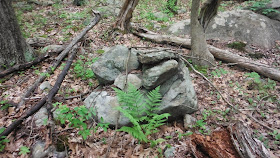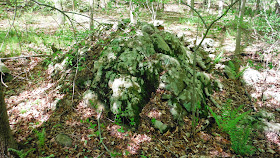Pages
▼
Saturday, May 31, 2014
Friday, May 30, 2014
Hokey Smokes!
While many of the "cleaned up" stones piles at Acton's Trail Through Time on Peter's post of 5/29/14 {http://rockpiles.blogspot.com/2014/05/actons-trail-through-time-nashoba-brook.html} reminded me of the stone piles in my own Chickenyard Through Time here at Happiness Farm in Woodbury CT, there is one particular stone pile that made me exclaim out loud (and wake up the cat) when I saw it:
PWAX Photo
You may or may not say "Hokey Smokes!" when you see this, the first clue to me that what I assumed were old farm heap's o'trash and "cleared out of the way on a non-existent wilderness on the one-time (1659) Frontier of European Colonial Civilization to tidy up around one of the oldest houses still standing" stone refuse piles were actually Indigenous Stone Piles. I was gathering wood and picked up a small branch by the old chicken coop when I first noticed this rather Testudinate grouping of stones:
Actually that is not my first photo of the Petroform, but a much better one taken after some of my own careful clearing and cleaning a few years later. Do I know exactly why there seems to be one bigger wide foreleg and one smaller more sort of pointed foreleg on many other Turtle Petroforms I believe I see? No, I don't. I just know that it is sometimes but not all the time so.
I'll highlight and desecrate Peter's photo to show you what I mean:
The forelegs may be reversed on the sides of a similarly shaped head stone but I think I see them clearly. And while not identical but similar, the same may be true of the carapace stone with a similar pointed nuchal scute thing going on (as opposed to a recessed "notch"), the Chickenyard Petroform as it is seems more realistically sized, although the two stones beside the Acton Petroform may suggest there may or may not be some stone scutes missing from the construction that as it is doesn't seem as realistic a representation. Note that smallish lighter colored stone in both stone piles between both possible head stones and right front forelegs. In the Chickenyard, they appear to possibly be stones to prop the carapace up so that the legs could fit into that upper shell properly...
Feel free to say "Hokey Smokes!"
Thursday, May 29, 2014
Monday, May 26, 2014
Scuppo Rd. Box Turtle Surprise
"Today's the day," I said to my grandson, "that we take a close look at that stone." I'd been saying "One of these days..." for quite a while and last Saturday was indeed the day. The area just became an "Open Space" property, although I'd taken a brief trespass into it a time or two - even had a Serpent Surprise there once a couple years ago: {http://wakinguponturtleisland.blogspot.com/2012/06/serpent-surprise.html}.
I wasn't even really 100% certain that this was either a boulder or a pile of stones until we got closer - and saw that it was actually both; the westerly side was stones while the other sides were boulder:
As we circled around (as if it would somehow get away from us), we saw that the boulder sort of looked like a pile of stones, something I'm sure might have a good sort of geological name:
A "pudding stone" boulder??
But that westerly side had a head-like feature that reminded me of a turtle, combined with a high-domed shell, that suggests, to me anyway, a box turtle:
(- and those may be feet to the bottom left - maybe a second turtle head.
Could it be two turtles, giving this post at least an R-rating?)
Enhanced:
Box Turtle Shaped Boulder and Stones (or Testudinate Petroform) on left,
man shaped man with hat shaped hat on right:
And perhaps that is another turtle nearby:
A single stone petroform perhaps, just the head and shell apparent, I'm sure there will be future posts from further investigations - my grandson mentioned finding a cave at one time...
Sunday, May 25, 2014
Recognizing Possible Testudinate Indigenous Stonework
"The Turtle just might be the Key to the
Language of the Indigenous Stonework of Turtle Island," I'm thinking, mashing up the title of something written by Roger Williams, as I am drinking some coffee on a quiet Sunday morning. I'm looking for an image of the Bronx River turtle petroglyph, but can't find a good one.
I give up on getting a petroglyph turtle image for this, go into the kitchen and get a second cup:
I suppose that making a petroform turtle is similar to carving a petroglyph turtle or drawing one: start with a shape that resembles a shell, add some legs and a head, maybe a tail, and you're done:
Since I live on what was once called
Turtle Island, I was not surprised to find a Testudinate pattern as one of many
in the remnants of Indigenous Stonework (although I admit I was surprised to find the one in the first photo above and in the photo below, on what I assumed was a pile of junk that had been accumulating on top of some field clearing stones near the Old Chicken Coop here at Happiness Farm since the first quarter of the 18th century). I think of this as
the composite method of creating a stone turtle effigy. I see this repeated
often locally – stones that resemble a shell or carapace are often enhanced
with stones that resemble two forelegs, sometimes two hind legs, and a
triangular stone for the head of the turtle effigy:
But you know, all you might really need is just the shell and a suggestion of a head to trigger the "That's a Turtle!" response in another person's brain:
Did someone find that stone above or did they shape that stone? If they shaped it, how did they know that head-like inclusion would be in there? I can answer that question quickly and easily: I don't know. This one, much smaller, is not too far away from that mysterious single stone variation of a testudinate form, a pattern repeated often locally (and then some). It's similar, sort of, but the pieces are all there, unlike the other. I think I looked at it many times over many years before it dawned on me that those pieces might have been left there to convey the idea that they were the remains of the shell of the egg beside a baby turtle:
One more in the same group of stone mounds, since "two is good and three is better:"
I suppose even a kid with nothing else to do might hang around breaking random stones to see if they got lucky and found the prize Turtle-head-like inside. There are other little small stone turtles in this group of mounds that look to me as if a child might have created them:
Closer:
I suspect these mounds of stones (and possibly an adjacent row of stones) to have been plundered many times since the early 1700's simply because it was easy to do so. As I pick up some chunk of stone and mortar that has fallen off of some of the most recent of stone creations, I often wonder if it perhaps came from the mounds of stones up by the old coop...

.JPG)

+PWAX+Photo+as+T.jpg)









+Rhomboid.jpg)
































.jpg)












